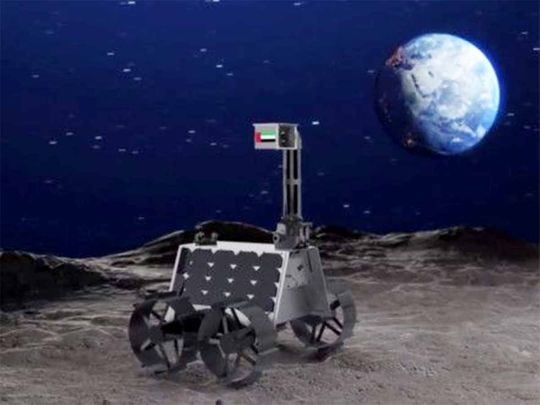
Dubai: The new launch date of moon-bound Rashid Rover will be on Wednesday, November 30, at 12.39pm UAE time, the Mohammed Bin Rashid Space Centre (MBRSC) has confirmed on Thursday.
“In collaboration with the partners – SpaceX and ispace, the integrated launch vehicle will start rolling out to the launch pad Space Launch Complex 40, Cape Canaveral Space Force Station in Florida ahead of launch,” MBRSC added.
A team from MBRSC is already at Kennedy Space Centre in Cape Canaveral, Florida for the launch of Rashid Rover.
MBRSC announced last week the launch date was November 28 but “is subject to change, depending on weather and other conditions at the launch site.”
MBRSC also confirmed Atlas Crater, located at 47.5°N, 44.4°E on the moon’s southeastern outer edge of Mare Frigoris (“Sea of Cold”), as the rover’s landing site.
Fuel-saving route
Once launched, the integrated spacecraft Hakuto-R M1 that will carry Rashid Rover and other payload to the moon will take a low-energy route to the moon rather than a direct approach, which means the landing will take about five months after launch, in April 2023.
Dr Hamad Al Marzooqi, project manager of Emirates Lunar Mission at MBRSC, earlier told Gulf News the rationale for the fuel-saving but long route. He said: “Main factor is the cost of the mission. The cost comes from the volume and mass of the spacecraft. In order to reach to the moon within six days which is the shortest path, you would need to burn a lot of fuel which means that you need a big tank and a big propulsion system to do that.”
“But it will have a huge impact in cost so, in order to reduce the cost of the mission, ispace (our partner) has selected their approach that they can reach to the lunar surface within five months but it will be less costly because it will burn much less fuel. They will use a smaller tank and propulsion system, therefore the launch cost and the cost of developing the developing system will be lower.”
Dimitra Atri, astrophysicist at New York University in Abu Dhabi, added: “In order to keep the prices of payload delivery attractive to customers, private companies reduce their expenses by choosing the lower cost option, which consumes less energy but takes much longer.”












